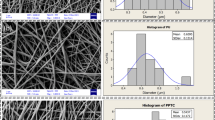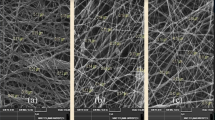Abstract
Porous poly(ε-caprolactone)/gelatin (P/g) scaffolds were electrospun at 18 wt% polymer concentration using a common solvent of diluted acetic acid and ethyl acetate to evaluate the effect of P/g weight ratio in the range of 9/1–5/5 on mechanical properties, porosity, moisture vapor transmission rate (MVTR), and biocompatibility of scaffolds. The precursor solution exhibited a gelatin concentration-dependent decrease in viscosity and increase in conductivity in the range of P/g ratios from 9/1 to 5/5 in the scaffolds. Fourier transform infrared spectroscopy (FT-IR) results showed an interaction of hydrogen (H) bond between the ester group (–COO) of PCL and the amine group (–NH2) of gelatin molecule in the P/g scaffold. The highest water uptake capacity (541%) and MVTR values (1522.3 ± 13.48 g/m2·24 h) were observed on the 7/3 P/g scaffold. The highest strength of 4.8 ± 0.6 MPa was observed on the 6/4 scaffold. The P/g scaffolds showed no evidence of causing cell lysis or toxicity. Among the scaffolds, 7/3 and 6/4 P/g scaffolds appeared to be suitable as wound dressings due to their excellent MVTR, water uptake capacity, cell viability, proliferation, attachment and mechanical strength.









Similar content being viewed by others
References
Archana D, Dutta J, Dutta P (2013) Evaluation of chitosan nano dressing for wound healing: characterization, in vitro and in vivo studies. Int J Biol Macromol 57:193–203
Binulai NS, Natarajan A, Menon D, Bhaskaran VK, Mony U, Nair SV (2014) PCL-gelatin composite nanofibers electrospun using diluted acetic acid-ethyl acetate solvent system for stem cell-based bone tissue engineering. J Biomater Sci 25:325–340
Chellamani KP, Sundaramoorthy P, Suresham T (2012) Wound dressing made out of polyvinyl alcohol/chitosan nanomembranes. J Acad Indus Res 1:342–347
Gautam S, Dinda AK, Mishra NC (2013) Fabrication and characterization of PCL/gelatin composite nanofibrous scaffold for tissue engineering applications by electrospinning method. Mater Sci Eng C 33:1228–1235
Ghasemi-Mobarakeh L, Prabhakaran MP, Morshed M, Nasr-Esfahani M, Ramakrishna S (2008) Electrospun poly(ε-caprolactone)/gelatin nanofibrous scaffolds for nerve tissue engineering. Biomater 29:4532–4539
Jeong H, Rho J, Shin J, Lee DY, Hwang T, Kim KJ (2018) Mechanical properties and cytotoxicity of PLA/PCL scaffolds. Biomed Eng Lett 8:267–271
Ke R, Yi W, Tao S, Wen Y, Hongyu Z (2017) Electrospun PCL/gelatin composite nanofiber structures for effective guided bone regeneration membranes. Mater Sci Eng C 78:324–332
Khalili AA, Ahmad MR (2015) A review of cell adhesion studies for biomedical and biological applications. Intl J Mol Sci 16:18149–18184
Kim D, Lee M, Lee DY, Han J (2000) Mechanical properties, phase stability, and biocompatibility of (Y, Nb)-TZP/Al2O3 composite abutments for dental implant. J Biomed Mater Res 53:438–443
Kim Y, Son S, Chun C, Kim J, Lee DY, Choi HJ, Kim T, Cha E (2016) Effect of PEG addition on pore morphology and biocompatibility of PLLA scaffolds prepared by freeze drying. Biomed Eng Lett 6:287–295
Kim S, Shin J, Yun Y, Lee DY, Yang D, Kim B, Song Y (2019) Characteristics of piezoelectric polymeric PVDF sensor by impact testing. Polym Korea 43:764–770
Kim S, Lim H, Kim S, Lee DY (2020) Effect of PVA concentration on strength and cell growth behavior of PVA/gelatin hydrogels for wound dressing. J Biomed Eng Res 41:1–7
Kuppan P, Sethuraman S, Krishnan UM (2013) PCL and PCL-gelatin nanofibers as esophageal tissue scaffolds: optimization, characterization and cell-matrix interactions. J Biomed Nanotechnol 9:1–16
Lee DY, Kim B, Lee S, Lee M, Song Y, Lee J (2006) Titania nanofibers prepared by electrospinning. J Korean Phys Soc 48:1686–1690
Lee SM, Park IK, Kim YS, Kim HJ, Moon H, Mueller S, Jeong Y (2016) Physical, morphological, and wound healing properties of a polyurethane foam-film dressing. Biomater Res 20:37
Lim H, Shin J, Lee DY, Kim B, Song Y (2020) Drug delivery behavior of PCL and PCL/PEG microcapsules prepared by high-speed agitator and syringe pump. Polym (korea) 44:487–494
Longhao J, Park K, Yoon Y, Kim HS, Kim HY, Choi JW, Lee DY, Chun HJ, Yang DH (2021) Visible light-cured antibacterial collagen hydrogel containing water-solubilized triclosan for improved wound healing. Mater 14:2270
Oh G, Rho J, Lee DY, Lee M, Kim Y (2018) Synthesis and characterization of electrospun PU/PCL hybrid scaffolds. Macromol Res 26:48–53
Salehi M, Niyakan M, Ehterami A, Haghi-Daredeh S, Nazarnezhad S, Abbaszadeh-Goudarzi G, Vaez A, Hashemi SF, Rezaei N, Mousavi SR (2020) Porous electrospun poly(ε-caprolactone)/gelatin nanofibrous mat containing cinnamon for wound healing application, in vitro and in vivo study. Biomed Eng Lett 10:149–161
Seol B, Shin J, Oh G, Lee DY, Lee M (2017) Characteristics of PU/PEG hybrid scaffolds prepared by electrospinning. J Biomed Eng Res 38:248–255
Shin J, Jeong H, Lee DY (2018) Synthesis of PVA/NaCMC hydrogels crosslinked by cyclic freezing/thawing and subsequent gamma-ray irradiation and their properties. J Biomed Eng Res 39:161–167
Shin J, Lee DY, Yoon JI (2020a) Effect of CMC concentration on cell growth behavior of PVA/CMC hydrogel. Macromol Res 28:813–819
Shin J, Lee DY, Kim B, Yoon JI (2020b) Effect of polyethylene glycol molecular weight on cell growth behavior of polyvinyl alcohol/carboxymethyl cellulose/polyethylene glycol hydrogel. J Appl Polym Sci 137:49568
Son S, Choi J, Cho H, Kang D, Lee DY, Kim J, Jang J (2015) Synthesis and characterization of porous poly((ε-caprolactone)/silica nanocomposites. Polym (korea) 39:323–328
Acknowledgements
This work was supported by the Materials & Components Technology Development Program (Project No. 20003560), funded by the Ministry of Trade, Industry & Energy (MOTIE, Korea).
Funding
Ministry of Trade, Industry and Energy, 20003560, Deuk Yong Lee.
Author information
Authors and Affiliations
Corresponding author
Ethics declarations
Conflict of interests
On behalf of all authors, the corresponding author states that there is no conflict of interest.
Additional information
Publisher's Note
Springer Nature remains neutral with regard to jurisdictional claims in published maps and institutional affiliations.
Rights and permissions
About this article
Cite this article
Song, YS., Kim, BY., Yang, D.H. et al. Poly(ε-caprolactone)/gelatin nanofibrous scaffolds for wound dressing. Appl Nanosci 12, 3261–3270 (2022). https://doi.org/10.1007/s13204-021-02265-w
Received:
Accepted:
Published:
Issue Date:
DOI: https://doi.org/10.1007/s13204-021-02265-w




